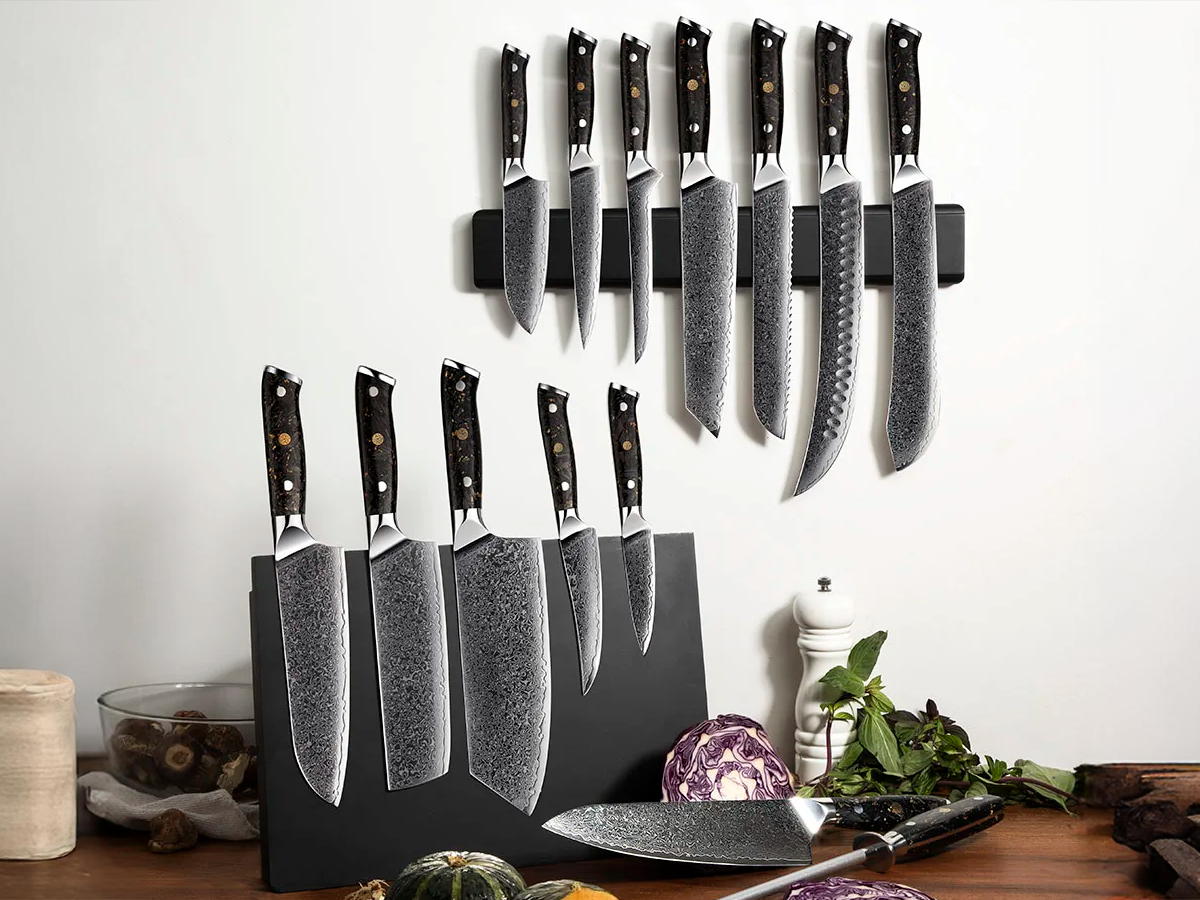Adding Style and Functionality to Your Kitchen
At Hikari, we believe that a great kitchen knife is not just about performance but also about aesthetics and craftsmanship. The finish on a knife blade is an important aspect that contributes to its overall look, feel, and functionality. Here, we explore the various finishes available in our store, each offering unique benefits and visual appeal.
Kurouchi Finish
The Kurouchi finish, also known as "blacksmith's finish," is a traditional Japanese blade finish characterized by its rustic and dark appearance.
This finish is created by leaving the black oxide scale formed during the forging process on the blade. The dark, matte appearance reduces glare, making it practical for use in bright kitchens.
While the Kurouchi finish provides some protection against rust and corrosion, it does require regular maintenance to preserve its rustic beauty and functional integrity.
Hammered Finish
A hammered finish features a series of small, intentional dents on the blade surface, often created by a hammer during the forging process.
This texture adds a handcrafted, artisanal touch to the knife. The dimples reduce the surface area that food can stick to, making it easier to slice through sticky ingredients like potatoes and apples.
The hammered finish beautifully combines form and function, making it a popular choice among both professional chefs and home cooks.
Damascus Finish (67-Layer)
The Damascus finish involves layering multiple types of steel and forging them together to create a distinctive, wavy pattern on the blade.
This intricate pattern makes each knife unique and visually stunning. Beyond its aesthetic appeal, the layered construction of Damascus steel provides a balance of hardness and flexibility, enhancing the blade's edge retention and overall performance.
The beauty and craftsmanship of a 67-layer Damascus knife make it a prized possession in any kitchen, reflecting the rich tradition of Japanese knife-making.
Damascus Copper Finish (37-Layer)
The Damascus Copper finish takes the artistry of Damascus steel a step further by incorporating layers of copper into the mix.
This results in a striking, contrasting pattern that adds a unique visual element to the knife. The addition of copper not only enhances the knife's aesthetic appeal but also contributes to its balance and flexibility.
A 37-layer Damascus Copper knife is a true work of art, blending the traditional techniques of Japanese blacksmiths with modern materials to create a standout piece in any culinary collection.
Polished Finish
A polished finish is achieved by grinding and buffing the blade to a high shine, creating a smooth and reflective surface.
This high-gloss finish gives the knife a sleek, modern look that appeals to those who prefer a contemporary aesthetic in their kitchen tools. The smooth surface of a polished blade is easy to clean and maintain, ensuring that the knife remains as beautiful as it is functional.
However, the reflective surface can cause glare in bright kitchens and may show fingerprints more easily.
Carbon Coating
Carbon coating involves applying a thin layer of carbon-based material to the blade, enhancing its durability and appearance.
This modern finish provides a sleek, matte look that appeals to contemporary aesthetics while also improving the blade's resistance to wear and corrosion. The added durability of a carbon-coated blade makes it a practical choice for those who demand high performance and longevity from their kitchen knives.
Proper maintenance is required to preserve the integrity of the carbon coating, ensuring that the knife remains both beautiful and functional.
Sandblasting
Sandblasting is a process where the blade surface is blasted with fine sand particles, creating a uniform, matte finish.
This non-reflective finish reduces glare, making it easier to use under bright lights. The slightly rough texture of a sandblasted blade can also improve grip during cutting, enhancing the knife's functionality.
While the utilitarian look of sandblasting may not appeal to everyone, its practical benefits make it a popular choice among those who prioritize performance in their kitchen tools.
Titanium Plating
Titanium plating involves coating the blade with a thin layer of titanium, enhancing both performance and appearance.
This modern finish provides excellent resistance to rust and staining, making it ideal for those who want a low-maintenance, high-performance knife. The durability of a titanium-plated blade is unmatched, with the coating adding an extra layer of protection against wear and tear.
Additionally, titanium plating is available in various colors, allowing for a visually striking knife that stands out in any kitchen. Proper care is needed to maintain the integrity of the titanium coating, ensuring the knife remains a functional and beautiful tool.
Conclusion
At Hikari, we offer a wide range of blade finishes to suit every chef's needs and preferences.
Whether you prefer the rustic charm of a Kurouchi finish, the artisanal touch of a hammered blade, or the modern elegance of a polished or titanium-plated knife, our collection ensures you'll find the perfect match for your kitchen.
Each finish not only adds to the knife's aesthetic appeal but also enhances its functionality, making your cooking experience even more enjoyable.














Leave a comment
This site is protected by hCaptcha and the hCaptcha Privacy Policy and Terms of Service apply.